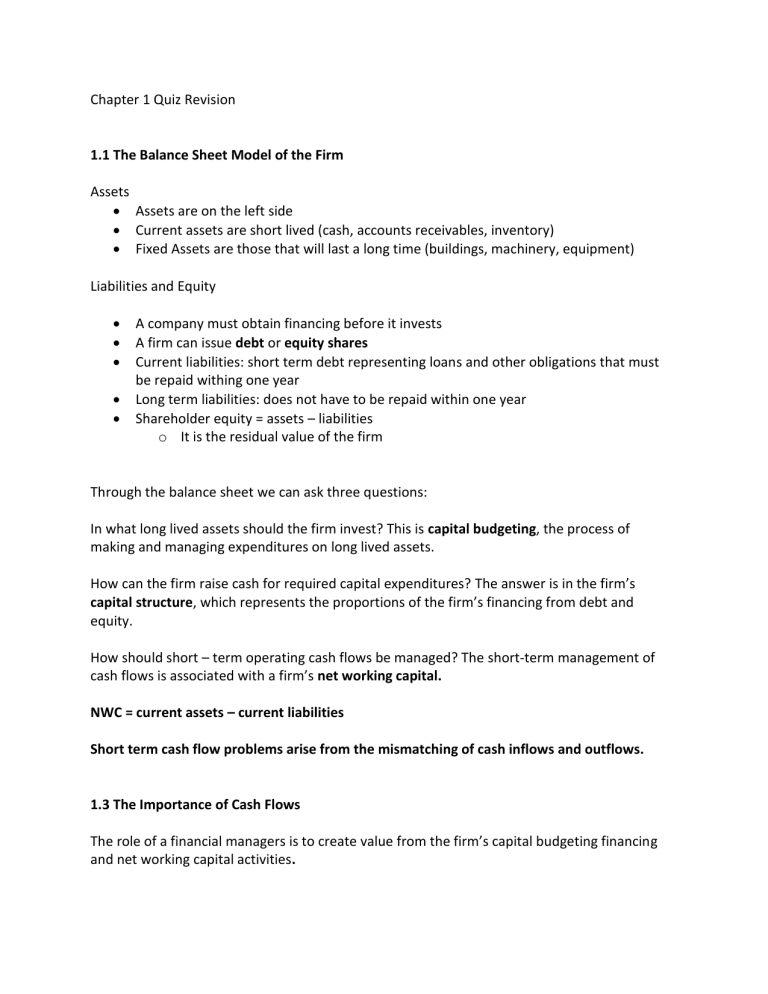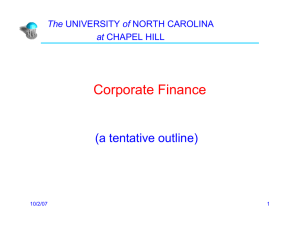
Chapter 1 Quiz Revision 1.1 The Balance Sheet Model of the Firm Assets Assets are on the left side Current assets are short lived (cash, accounts receivables, inventory) Fixed Assets are those that will last a long time (buildings, machinery, equipment) Liabilities and Equity A company must obtain financing before it invests A firm can issue debt or equity shares Current liabilities: short term debt representing loans and other obligations that must be repaid withing one year Long term liabilities: does not have to be repaid within one year Shareholder equity = assets – liabilities o It is the residual value of the firm Through the balance sheet we can ask three questions: In what long lived assets should the firm invest? This is capital budgeting, the process of making and managing expenditures on long lived assets. How can the firm raise cash for required capital expenditures? The answer is in the firm’s capital structure, which represents the proportions of the firm’s financing from debt and equity. How should short – term operating cash flows be managed? The short-term management of cash flows is associated with a firm’s net working capital. NWC = current assets – current liabilities Short term cash flow problems arise from the mismatching of cash inflows and outflows. 1.3 The Importance of Cash Flows The role of a financial managers is to create value from the firm’s capital budgeting financing and net working capital activities. How do financial managers create value? Try to buy assets that generate more cash than they cost Sell bonds, stocks and other financial instruments that raise more cash than they cost The firm must create more cash flow than it uses: the cash flows paid to bondholders and stockholders of the firm should be greater than the cash flows put into the firm by bondholders and stockholders. To raise money, the firms sell debt and equity shares to investors in financial markets. This is a cash flow from financial markets to the Firm. This cash is then invested in the assets of the firm. The cash that is generated is paid to shareholders and bondholders. The shareholders receive cash in the form of dividends, and the bondholders receive interest and the principal back. not all of the cash is paid out; some is retained, and some is paid in taxes. Value is created when the cash paid to shareholders and bondholders is greater than the cash raised in the financial markets. 1.5 The Agency Problem and Control of the Corporation Conflicting interests between stockholders and managers Stockholder (principal) and management (agent) Direct costs of these conflicts o Corporate expenditure that benefits managers (private jets) o Cost related to monitoring managers or auditing Indirect costs o Lost opportunities because management did not pursue How can you align their interests? Managerial compensation to motivate them – stock options Control of the firm – ability to remove management Shareholders vs debtholders?? 1.6 Regulation The securities act of 1933 and the securities act of 1934 o 1933: reporting and disclosure o 1934: insider trading Sarbanes Oxley 2002 o Law for shareholders to be protected against corporate abuses o Enron corporate fraud that was happening at the CEO/CFO level, affecting the stockholders when everything collapsed



